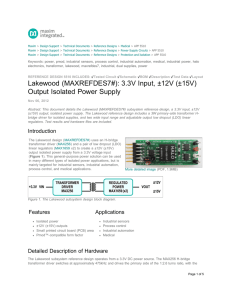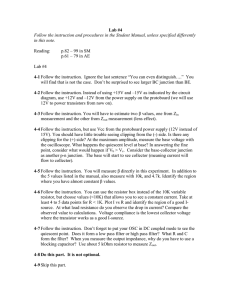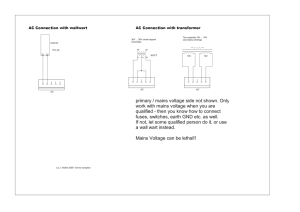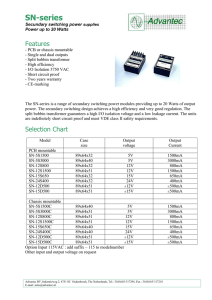3.3v input, ±12v (±15v) output isolated power supply
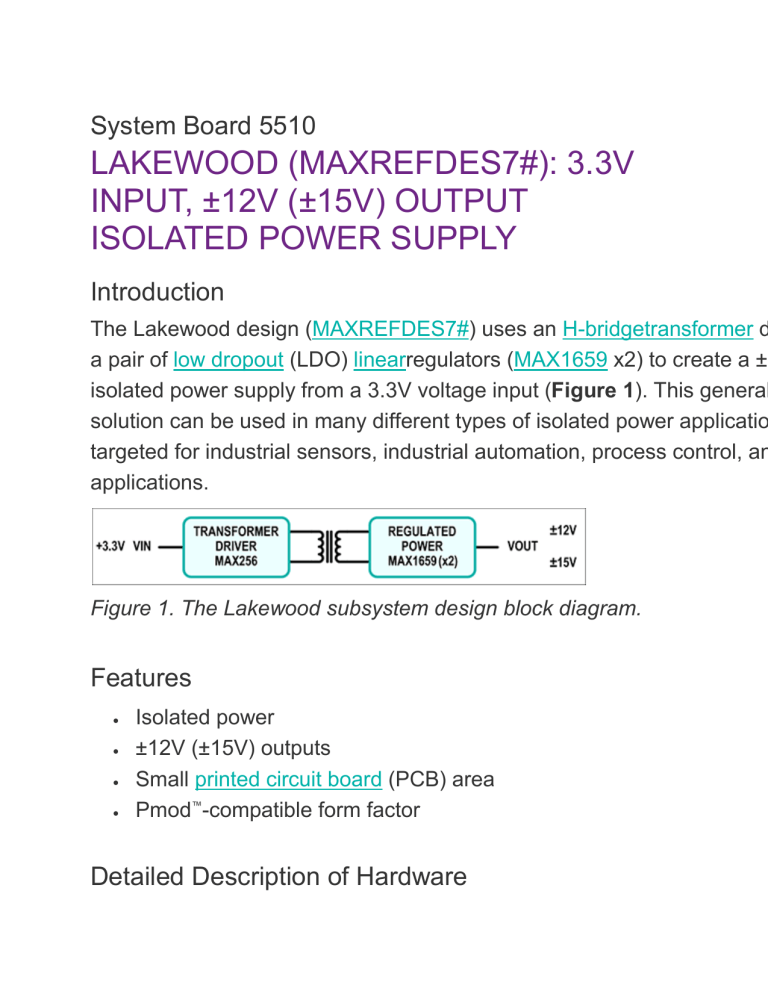
System Board 5510
LAKEWOOD (MAXREFDES7#): 3.3V
INPUT, ±12V (±15V) OUTPUT
ISOLATED POWER SUPPLY
Introduction
The Lakewood design ( MAXREFDES7# ) uses an H-bridgetransformer driver ( MAX256 ) and a pair of low dropout (LDO) linear regulators ( MAX1659 x2) to create a ±12V (±15V) output isolated power supply from a 3.3V voltage input ( Figure 1 ). This general-purpose power solution can be used in many different types of isolated power applications, but is mainly targeted for industrial sensors, industrial automation, process control, and medical applications.
Figure 1. The Lakewood subsystem design block diagram.
Features
Isolated power
±12V (±15V) outputs
Small printed circuit board (PCB) area
Pmod ™ -compatible form factor
Detailed Description of Hardware
Applications
Industrial sensors
Process control
Industrial automation
Medical
The Lakewood subsystem reference design operates from a
3.3V DC power source . The MAX256 H-bridge transformer driver switches at approximately 475kHz and drives the primary side of the 1:2.6 turns ratio, with the use of a TGM-
H281NF transformer from Halo ® Electronics. The transformer secondary side is connected to voltage doublers that rectify the AC outputs into DC outputs. Two MAX1659 LDOs regulate the voltages to +12V and -12V, respectively. The
Zener diodes (D3 and D6) protect the LDOs by keeping their input voltages below 16.1V.
The input power can be from the J1 Pmod-compatible connector or from an external power supply connected to the
EXT_+3.3V and DGND connectors. To change the output voltages of this reference design, simply change the feedback resistors (R2 –R5) of the LDOs (U2 and U3).
The output voltage of the MAX1659 LDOs is set by the following equations:
V
OUT
= V
SET
× (1 + R2/R3) for U2 V
OUT
= V
SET
× (1 + R4/R5) for
U3
Where VSET = 1.21V.
For example, for the ±15V outputs application, change R2 and
R4 to 187kΩ, and change R3 and R5 to 16.2kΩ.
This circuit can also be configured for asymmetrical applications.
In applications sensitive to output voltage ripple, a lowpass LC pi filter can be added in front of the LDO input.
The isolation transformer in this design has an isolation voltage of 1500VRMS. It is recognized by UL 60950 and EN
60950 and falls into the "functional" insulation class.
Quick Start
Required equipment:
Lakewood (MAXREFDES7#) board
3.3V 1A power supply
Two digital voltmeters
Procedure
The Lakewood board is fully assembled and tested. Follow the steps below to verify board operation.
1. Place the shunt on jumper JU1 to the 1 –2 position.
2. Connect the positive terminal of the power supply to the
EXT_+3.3V connector.
3. Connect the negative terminal of the power supply to the
DGND connector.
4. Connect the positive terminal of the first voltmeter to the
+12V connector.
5. Connect the negative terminal of the first voltmeter to the
GND1 connector.
6. Connect the positive terminal of the second voltmeter to the -12V connector.
7. Connect the negative terminal of the second voltmeter to the GND2 connector.
8. Turn on the power supply.
9. Use the respective voltmeters to measure the corresponding positive and negative output voltages.
Lab Measurements
The Lakewood design was tested for two pairs of output voltage rails: ±12V and ±15V. Other voltage rails can be achieved by modifying the resistor values of R2, R3, R4, and
R5. When set for ±12V outputs, the circuit can deliver a maximum load current of approximately 90mA for each of the two rails simultaneously. When set for ±15V outputs, the circuit can deliver a maximum load current of approximately
40mA for each of the two rails simultaneously.
To achieve a larger maximum load, the user can either increase the input power supply voltage or increase the transformer turns ratio properly. Refer to the MAX256 data sheet for details. The power efficiencies are illustrated in Figure 2 and Figure 3 .
For asymmetrical voltage level applications, the maximum load can be larger for one rail and less for the other rail.
Figure 2. Power efficiency vs. current load for ±12V outputs.
Figure 3. Power efficiency vs. current load for ±15V outputs.
The output noise is well below 0.5% of the output voltages.
The noise is mainly due to the switching pulses of the
MAX256. Figure 4 and Figure 5 display the noise at no load for 12V and 15V outputs, respectively. Figure 6 and Figure
7 display the noise at the maximum loads for 12V and 15V outputs, respectively.
The noise on the negative rails is identical to the positive rails for symmetrical load applications.
Figure 4. Noise at VOUT = 12V, IOUT = 0mA.
Figure 5. Noise at VOUT = 15V, IOUT = 0mA.
Figure 6. Noise at VOUT = 12V, IOUT = 90mA.
Figure 7. Noise at VOUT = 15V, IOUT = 40mA.
